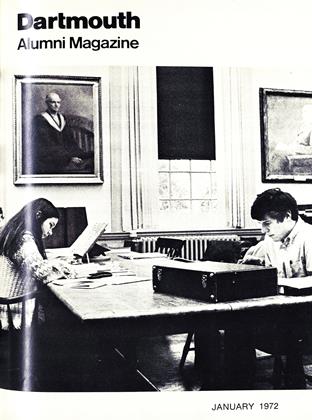"The publication of The Vinland Map andthe Tartar Relation by the Yale University Press in 1965 set off one of the most vigorous debates ever seen in the world of historical scholarship" writes Wilcomb E. Washburn '48.
Because the publication nearly coincided with Columbus Day, a number of laymen imagined it to be an attack on the dogma that Columbus discovered America, and they flew into jingoistic debate. The scholarly world, aware from saga evidence that the Vikings had sailed to America before Columbus, became embroiled in its own heated arguments concerning the authenticity of the map. Both controversies still rage.
As Director of the American Studies Program at the Smithsonian Institution and Adjunct Professor at American University, Mr. Washburn was a central figure at the Vinland Map Conference held at the Smithsonian in 1966 and attended by 43 participants from international centers of learning with papers contributed by 16 scholars.
The Yale University Press book stimulated debate neither scholarly nor historical. In the Preface to Proceedings of the Vinland MapConference, 1971, which Mr. Washburn has edited, he writes, "Reactions varying from wounded national pride to scholarly outrage at the secrecy under which the book had been prepared caused the historical pot not only to boil but to run over. The cause of the controversy was a crude map of the world which the authors of the book, R.A. Skelton, Thomas E. Marston, and George D. Painter, concluded to be the mid-fifteenth-century work of a copyist working in the region of Basel, Switzerland. ... What made the map unique was the appearance of a large landmass west of Greenland captioned Vinlanda Insula. ... If the map were genuine, it would be the only known map made prior to the voyage of Columbus showing clearly and unequivocably... the existence of America."
Representing the current knowledge about the Vinland Map, the Smithsonian Conference Papers incorporate the full range of scholarly insights of linguists, historians, canon law specialists, and cartographic experts. There was no attempt to establish the authenticity of the map or to deny it but merely to facilitate an exchange of views on the subject and to disseminate the results to the scholarly world.
Costing $10, the volume, one of the monograph series of the Society for the History of Discoveries, is published by the University of Chicago Press for The Newberry Library. Mr. Washburn is Chairman of the Board of Studies in The History of Discoveries.
Paul J. Fredyma '48 and Marie-Louise Fredyma of Hanover have studied and collected silver for 20 years. They are authors of A Directory of New HampshireSilversmiths and Their Marks, which for the first time provides collectors and museums with a complete listing of New Hampshire silversmiths and also names of men (or firms) who might be New Hampshire craftsmen with documentation presently lacking. Also included are a half dozen names of newly discovered New Hampshire smiths and their marks. Limited to 500 copies, with 175 listed names and corrections in spellings and misinformations in other published works, the booklet, 20 pages, may be obtained from the authors for $3.25 post free.
 View Full Issue
View Full Issue
More From This Issue
-
 Feature
FeatureThe Dartmouth Plan
January 1972 By C.E.W. -
 Feature
FeatureAlumni Giving Adds $13.9 Million in Year
January 1972 -
 Feature
FeatureConserver of the Crafts
January 1972 -
 Feature
FeatureAnti-Bigot
January 1972 By MARY ROSS -
 Feature
FeatureThe American Dream
January 1972 By A.T.G. -
 Article
ArticleThe Undergraduate Chair
January 1972 By RICHARD M. ZUCKERMAN '72
JOHN HURD '21
-
 Article
Article"Suicide" Is Not for Cowards
March 1948 By JOHN HURD '21 -
 Books
BooksSKIING
May 1952 By John Hurd '21 -
 Books
BooksWINDOW IN THE SEA.
December 1956 By JOHN HURD '21 -
 Books
BooksBOSWELL IN SEARCH OF A WIFE, 1766-1769. Edited
January 1957 By JOHN HURD '21 -
 Books
BooksJOHN JAY, FOUNDER OF A STATE AND NATION.
MARCH 1969 By JOHN HURD '21 -
 Books
BooksA GUIDE TO BEHAVIORAL ANALYSIS AND THERAPY.
DECEMBER 1972 By JOHN HURD '21
Books
-
 Books
BooksTHE CONNECTICUT RIVER AND OTHER POEMS
February 1940 -
 Books
BooksSet of Freud Presented
JUNE 1967 -
 Books
BooksNO SUBSTITUTE FOR VICTORY.
DECEMBER 1962 By CHARLES B. McLANE '41 -
 Books
BooksTHE MAIN STREAM OF FRENCH LITERATURE.
December 1932 By Charles R. Bagley -
 Books
BooksNO TIME FOR SCHOOL, NO TIME FOR PLAY: THE STORY OF CHILD LABOR IN AMERICA.
NOVEMBER 1972 By JOHN HURD '21 -
 Books
BooksDARTMOUTH SONG BOOK
April 1950 By JUD LYON '4O


